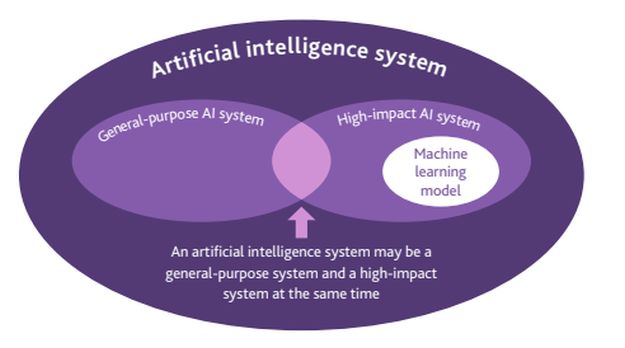- within Technology topic(s)
- with Senior Company Executives and HR
- with readers working within the Oil & Gas industries
Overview & scope
Overview
Name
An Act Respecting Artificial Intelligence Systems and Data Used in Artificial Intelligence Systems (the "Artificial Intelligence and Data Act" – "AIDA")*, including the proposed amendments sent by Minister Champagne on November 28, 2023, forms part of Bill C-27 currently before the House of Commons.
Purposes
AIDA aims to establish common requirements for the design, development and use of AI systems, and prohibit certain conduct that may result in harm to individuals.
Requirements
AIDA includes various requirements for AI systems before being put on the market, including assessing potential adverse impacts, taking measures to assess and mitigate risks, enabling human oversight, reporting serious incidents, and keeping relevant records.
Enforcement
AIDA would be administered and enforced by the Minister of Innovation, Science, and Industry, and the (newly formed) Artificial Intelligence and Data Commissioner.
Penalties
AIDA provides two types of penalties for regulatory non-compliance— administrative monetary penalties and prosecution of regulatory offences—as well as a separate mechanism for true criminal offences.
Scope
Material
"Artificial intelligence system" (or "AI system"), which may include general-purpose system and/or high-impact system. (arts. 2 and 5(2) AIDA)

Organizational
"Person" (e.g., trust, joint venture, partnership, unincorporated association or any other legal entity) in the private sector, excluding: (art. 2 and Part 1 AIDA)
- Government institutions as defined in section 3 of the Privacy Act (departments, ministries of state, bodies listed in the Schedule and Crown corporations and their subsidiaries). (art. 3(1) AIDA)
- Product, service or activity under the direction or control of (a) the Minister of National Defence; (b) the Director of the Canadian Security Intelligence Service; (c) the Chief of the Communications Security Establishment; or (d) any other person who is responsible for a federal or provincial department or agency and who is prescribed by regulation. (art. 3(2) AIDA)
Temporal
New and existing AI systems (for the latter,
the deadline for compliance will be prescribed by
regulation).
(arts.7(3), 8(2), 8.2(2), 9(3), 9.1(2), 10(3), 10.1(2),
11(2), 12(2) and 12(4) AIDA)
Territorial
"In the course of international or interprovincial
trade and commerce across Canada."
(art. 4 AIDA)
Unlike the EU AI Act, which broadly applies to providers or deployers outside the EU, AIDA has a similar territorial scope of application as Canada's Personal Information Protection and Electronic Documents Act (PIPEDA) and therefore can be expected to be interpreted to have application to organizations with a "real and substantial connection to Canada". This could include the development, design or management of an AI system in Canada or its use in Canada in a manner that is deemed to create a real and substantial connection to Canada. Foreign organizations doing business in Canada or providing AI services to Canadians should be mindful of their potential compliance responsibilities under AIDA.
AI system
Definitions
"Artificial Intelligence System" (or "AI system") means a technological system that, using a model, makes inferences in order to generate output, including predictions, recommendations or decisions. (art. 2 AIDA)
- The Organisation for Economic Co-operation and Development (OECD)'s definition reads as follows: "An AI system is a machine-based system that, for explicit or implicit objectives, infers, from the input it receives, how to generate outputs such as predictions, content, recommendations, or decisions that can influence physical or virtual environments. Different AI systems vary in their levels of autonomy and adaptiveness after deployment."
- The Organisation for Economic Co-operation and Development (OECD)'s definition reads as follows: "An AI system is a machine-based system that, for explicit or implicit objectives, infers, from the input it receives, how to generate outputs such as predictions, content, recommendations, or decisions that can influence physical or virtual environments. Different AI systems vary in their levels of autonomy and adaptiveness after deployment."
"Biased Output" means content that is generated, or a decision, recommendation or prediction that is made, by an artificial intelligence system and that adversely differentiates, directly or indirectly and without justification, in relation to an individual on one or more of the prohibited grounds of discrimination set out in section 3 of the Canadian Human Rights Act, or on a combination of such prohibited grounds. It does not include content, or a decision, recommendation or prediction, the purpose and effect of which are to prevent disadvantages that are likely to be suffered by, or to eliminate or reduce disadvantages that are suffered by, any group of individuals when those disadvantages would be based on or related to the prohibited grounds. (art. 5(1) AIDA)
"Harm" means (a) physical or psychological harm to an individual, (b) damage to an individual's property, or (c) economic loss to an individual. Harms may be experienced by individuals independently or may be experienced broadly across groups of individuals. (art. 5(1) AIDA)
Obligations
Transparency. The person who manages the AI system must clearly and without delay inform individuals that they are communicating with an AI system if they believe they are communicating with another individual. (art. 6(1) AIDA)
- Exception. This does not apply if the system is a consumer product requiring the use of a physical product with a written statement indicating that the individual is communicating with an AI system. (art. 6(2) AIDA)
Other Obligations. An AI system may be subject to other obligations if it involves a general-purpose system, and/or a high-impact system, and/or machine learning model. See the following pages for more details.
General offence
Personal Information. Possessing or using personal information knowing or believing that the information is obtained or derived directly or indirectly as a result of an offence for the purpose of designing, developing, using or making available for use an AI system. (art. 38 AIDA)
Harm or Loss. Without lawful excuse and knowing that or being reckless as to whether the use of an artificial intelligence system is likely to cause serious physical or psychological harm to an individual or substantial damage to an individual's property, makes the artificial intelligence system available for use and the use of the system causes such harm or damage; or with intent to defraud the public and to cause substantial economic loss to an individual, makes an AI system available for use and its use causes that loss. (art. 39 AIDA)
Punishment. There is also the possibility of summary conviction, which includes a fine of not more than the greater of $20,000,000 and 4% of the person's gross global revenues in its financial year before the one in which the person is sentenced, in the case of a person who is not an individual. (art. 40b) AIDA)
To view the full article, click here.
Read the original article on GowlingWLG.com
The content of this article is intended to provide a general guide to the subject matter. Specialist advice should be sought about your specific circumstances.



